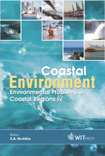Roughness Effects Upon The Near Sediment Turbulence Patterns
Price
Free (open access)
Transaction
Volume
58
Pages
Published
2002
Size
394 kb
Paper DOI
10.2495/CENV020151
Copyright
WIT Press
Author(s)
M A V Costa, S F C F Teixeira & J C F Teixeira
Abstract
In order to a better understanding of the coastal erosion, the effects of surface roughness on the turbulence in the vicinity of the sediment are investigated in this work. An experimental investigation in the flow structure near the interface of a simulated sediment bed is discussed. Experiments were carried out on a toroidal mini flume 131 mm in outer diameter and the data were taken using a commercial 2D LDA system. The simulated bed consisted of an aqueous solution of glycerine and two clay models, which were moulded on natural sediments in order to simulate the sediment interface. Results from the mean and turbulent velocities show that the shear stresses at the interface are strongly dependent upon the surface roughness. 1 Introduction The erosion of coastal sediments and the transport of suspended material have been extensively investigated in the past because it is a critical factor in the prediction of change of coastal environmental systems. The characteristics of the surface interface have a dominant influence on the frictional characteristics and turbulence formation in flows, and have both a direct (bed form migration) and indirect (enhanced suspension) effect on sediment transport [1]. The bed topology may affect the local flow patterns and therefore the erosion, due the existence of cavities and saliencies leading to the occurrence of recirculation pockets in its vicinity. Also, the presence of particles is related to the turbulent structure of the flow [2]. The annular type of flume has been recognized as an essential apparatus in the investigation of the properties of cohesive sediments, namely their erosion
Keywords





